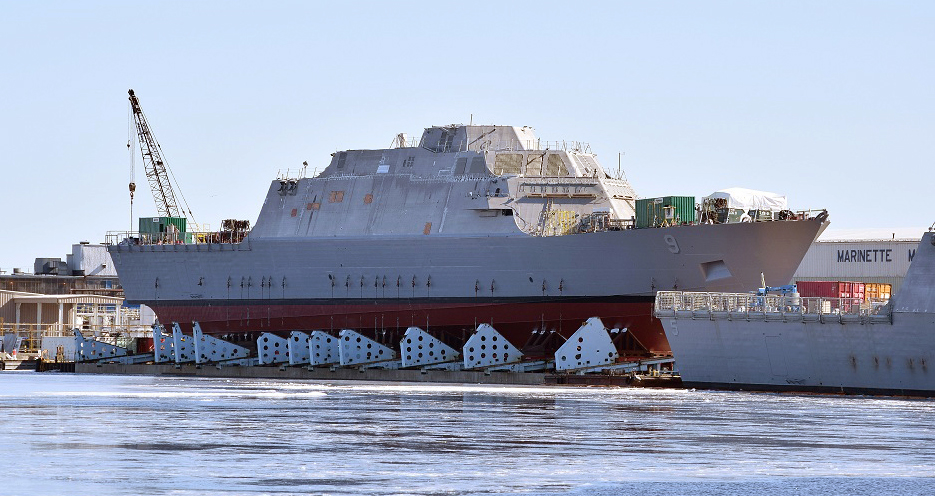
LCS-9, the future USS Little Rock, awaits launch.
Once, the Navy’s Littoral Combat Ship was a nightmare of cost overruns, schedule slips, and design flaws. That was especially true of Lockheed Martin’s LCS-1, the Freedom, with its hull cracks and electrical failures. Eight ships later, the design is fixed and the price has dropped by a third .
Production is moving at such a pace and has become so routine that Lockheed’s vice-president for LCS, Joe North, sometimes forgets which ship comes next.
“We’re up here this week [for] the launch of LCS-11, which is the future USS Sioux City — I’m sorry, LCS-9, which is the USS Little Rock,” North said, chagrined, in a conference call from Marinette. “Later this year, we will be launching LCS-11, which is Sioux City.”
Losing track is understandable. “We currently have seven ships in production up here,” North told reporters. LCS-9 will launch this Saturday and LCS-11 later this year. Work is well underway on LCS-13 and -15, while it has just started on LCS-17 is under production. LCS-19 and -21 are under contract, and Lockheed expects a contract for LCS-23 soon. (Even-numbered LCS are built by Austal in Alabama, which uses a completely different design).
The cost is currently about $358 million for the Freedom version and headed down to a low of $348.5 million. (Note these figures are for the ship itself and don’t include military equipment, such as weapons, that the government purchases separately, which can add over $100 million). The price has dropped steeply since the mismanaged early days of the program, when the Navy changed the design of LCS-1 and -2 midway through construction. Now the price is starting to level out. Costs will eventually climb back up slightly: After years of making LCS manufacture more efficient, the shipyard is reaching diminishing returns, while inflation in labor and materials is beginning to catch up.

So what’s unique about LCS-9? The future Little Rock is the first Lockheed LCS to be built entirely in Marinette’s revamped facilities. When Marinette was bought in 2008 by Fincantieri — on whose civilian designs the Lockheed LCS is based — the Italian company committed to a $73.5 million investment in the shipyard, parts of which dated to World War II. The more streamlined manufactured process reduces the distance ship components travel through the yard by eight miles, North said.
LCS-5 and LCS-7 were built as the yard was renovated around them, which some work done in the old facilities and some in the new. LCS-9 was built entirely in the new.
“The one thing we will not to do is…break production,” said North, “because we’ve already bid these ships and we already have contracts in place for them.” That means keeping the design the same — and resisting any urges to “improve” it that might increase cost or impose delay.
That said, the Navy is looking at an upgunned, upgraded, and more expensive variant of the LCS, designated a frigate. The current plan is for 32 of the existing LCS designs and 20 LCS frigates, but there’s considerable interest in cherry-picking some of the frigate’s improvements and adding them to the original-model LCS.
North made clear, however, that such upgrades would not be allowed to interfere with ongoing production: They “would probably be [done] in a backfit mode once we’re done and delivered here,” he said.
Lockheed is already looking at how to modify its LCS into the frigate design — but the details of what weapons and other equipment it has to carry are still being decided by the Navy. “We’re working…on cost and weight reductions to account for the fact that you’re going to get rid of large open module areas and fill them in” with new systems, North said. “They’re supposed to have final definition later this year [and] tell us what their final selection of systems is.”
Edited 5:30 pm to add cost data and chart.
Major trends and takeaways from the Defense Department’s Unfunded Priority Lists
Mark Cancian and Chris Park of CSIS break down what is in this year’s unfunded priority lists and what they say about the state of the US military.


























